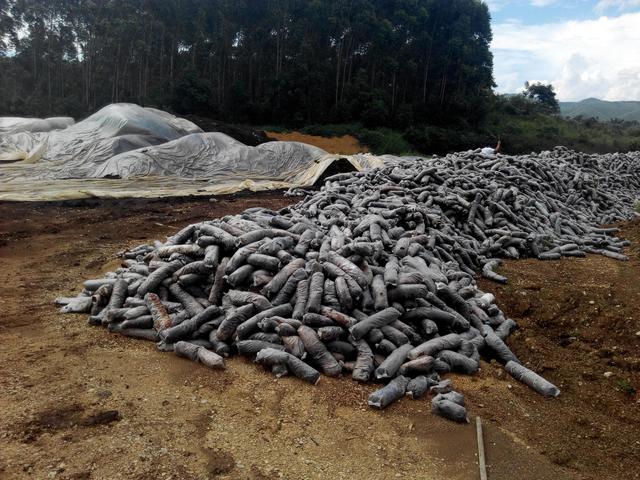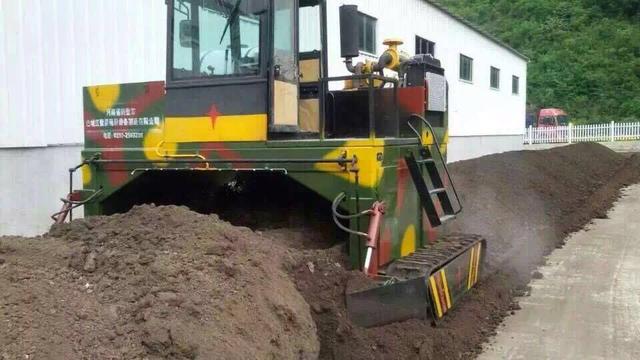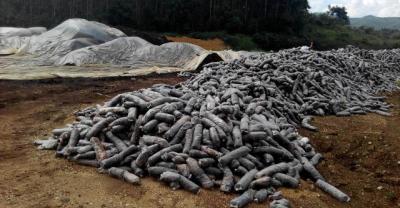Discussion on "aerobic" and "anaerobic" fermentation in the process of Horticultural fermentation Technology
Often see flower friends, ask how to ferment fish sausage ah, dung ah, noodles and other posts, for some flower friends said that a treasure said fermentation is sealed, some said not sealed. I am here to give a more scientific answer, I hope to be useful to everyone.

Fermentation site of pig manure + bacterial residue in a pitaya base
The choice of strains, I have posted on the forum the best fermentation with Japanese EM strains, for very flower friends, do not know where to buy. Now it's safe to say that it's possible to make bread with our yeast without EM strains.
What is EM strain?
EM strain is made up of bifidobacteria, lactic acid bacteria, bacillus, photosynthetic bacteria, yeast, actinomycetes, acetic acid bacteria and other single strains through special fermentation process, efficient composite microbial strain. The main function is to produce EM strain fermentation liquid-fermented biological feed, fermented biological fertilizer, sewage treatment, garbage deodorization and other products. (EM bacteria is a microbial preparation composed of yeast, lactic acid bacteria and photosynthetic bacteria.) In EM, photosynthetic bacteria group is aerobic and anaerobic, lactic acid bacteria group is anaerobic, yeast group is aerobic, filamentous bacteria group of fermentation system is anaerobic. Therefore, the fermentation process is aerobic and anaerobic fermentation, but the substances and functions produced by their fermentation are different.

The Turning Production Line of an Organic Fertilizer Factory in Guangxi
Attention!!! Anaerobic fermentation: Anaerobic fermentation is the stabilization of waste under anaerobic conditions by microbial metabolic activity, accompanied by changes in methane and CO2 production. (This process also produces hydrogen sulfide, which smells like rotten eggs.) This process may explain why fermented fish intestines and other things produce gases or odors. Sulfide concentrations affect the activity of methane bacteria, so it takes a long time to unscrew the lid and release the gases.

Hydrogen sulfide is a poisonous gas.
Solid fermentation must be aerobic fermentation (there will still be anaerobic fermentation inside). Fermented fish intestines and other things or liquid, in order to consider the feelings of neighbors, you can cover the day, deflate at night, ventilate for a few minutes, and then cover. In places where there are few people, you don't need to seal it (not without cover, you can also cover it with a film, remember not to expose it to the sun). In order to ferment successfully, when you ferment liquid fertilizer, you can add brown sugar +EM strains or yeast (it doesn't matter if you add more). Add 1 jin of water and 5~8 jin of water. After fermentation, remember to dilute it before using it. Fermented good finished product, sealed to prevent spoilage. Solid compost must be carried out according to a certain material ratio, moisture should be controlled well, can be 10 jin water + half jin brown sugar + yeast configuration, strain liquid. Or you can also expand your own strains (10 pounds of water + half a catty brown sugar + yeast + thermostat (fish culture that 40 degrees)+ oxygen (fish culture equipment) contact 10 hours) 24 hours later will see a surface film, this is the strain film. You can use this liquid directly as water fertilizer, or add fish intestines for fermentation.
Next article introduction (bacteria solution production process, welcome everyone's attention oh)
- Prev

The small balcony satisfies all my gardening dreams and teaches you how to build a balcony garden.
Growing flowers is a patient and meticulous job that requires interest. It takes several years to practice. It is recommended to try several kinds first, not taking up too much energy or investing too much money, and then.
- Next

On the sowing experience of succulent plants of the god of horticulture, from seeds to the growth of old stakes
First, about the container problem: 1. Container selection: 7MM small square basin, sowing 12 hole box, which material lunch box, fruit material box, Vientiane basin these are mostly used, others.
Related
- Wuhan Hospital Iron Tree Blooming Result Was Instantly Frightened by the Gardener Master
- Which variety of camellia is the most fragrant and best? Which one do you like best?
- What is the small blue coat, the breeding methods and matters needing attention of the succulent plant
- Dormancy time and maintenance management of succulent plants during dormancy
- Minas succulent how to raise, Minas succulent plant pictures
- What are the varieties of winter succulent plants
- How to raise succulent plants in twelve rolls? let's take a look at some experience of breeding twelve rolls.
- Attention should be paid to water control for succulent plants during dormant period (winter and summer)
- Watering experience of twelve rolls of succulent plants
- Techniques for fertilizing succulent plants. An article will let you know how to fertilize succulent plants.

